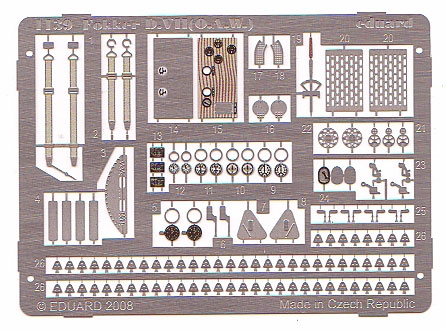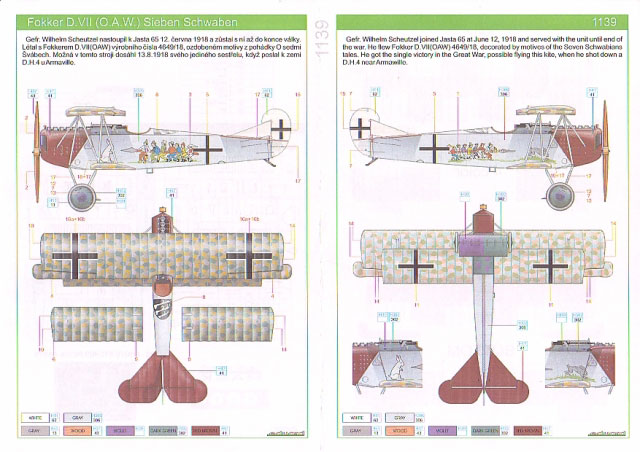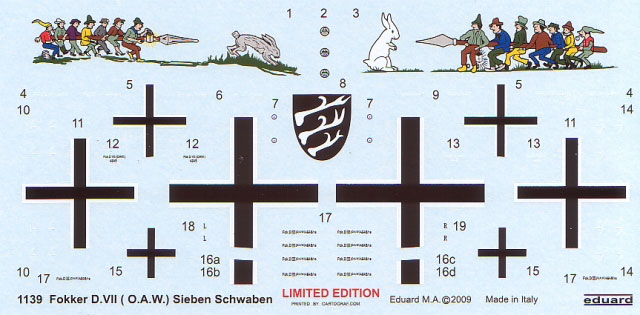|
Limited Edition
Fokker D.VII
“Sieben Schwaben”

Eduard, 1/48 scale
S
u m m a r y |
| Catalogue Number: |
Eduard Kit No. 1139 - Fokker D.VII Limited Edition “Sieben Schwaben” |
| Scale: |
1/48 |
| Contents and Media: |
92 parts in tan coloured plastic; 115 photo-etched parts; Express masks; markings for one aircraft |
| Price: |
USD$54.95 available online from Eduard
and hobby retailers worldwide |
| Review Type: |
FirstLook and FirstBuild |
| Advantages: |
Clean crisp mouldings; excellent fit; impressive detail; accurate outline; good use of photo-etched parts; decals in perfect register and minimal carrier film. |
| Disadvantages: |
|
| Conclusion: |
An unexpected but very welcome subject in 1:48 scale. The kit is an easy one to build and for those that require the next level of detailing, a superb fret of photo-etched parts is provided. |
Reviewed by
Rob Baumgartner

Eduard's 1/48 Fokker D.VII Limited Edition “Sieben Schwaben”
is available online from Squadron.com
One of the more detailed pieces of artwork seen on a Fokker D.VII will be found in Eduard's latest biplane boxing.
This is Eduard’s 1/48 scale limited release of a popular aircraft featuring the “Seven Swabians”. These characters are found on each side of the fuselage and are the product of a fairy tale from the Brothers Grimm.
It is an O.A.W. built machine that served with Jasta 65 during World War One. The pilot was Gefreiter Wilhelm Scheutzel and he shot down a DH4 on 13 August 1918 for his only victory of the war.
The kit contains the four sprues seen in previous releases with sprue “D” containing the appropriate OAW fuselage halves. In total there are 92 plastic parts and these are complimented by a further 115 photo etched items. Many of these are pre coloured which cater for the instrument panel, seatbelts, dial faces, and placards. The unpainted pieces allow for extra detailing to just about every other part of the airframe.
Express masks are another bonus and these simplify the painting of the wheel cover/tyre demarcation.
The cockpit is the first place to start and here we find a representation of the interior structure inside the fuselage halves. To this the usual fare is added such as the floor, rudder bar, seat, control column, compass and ammunition containers. Not forgotten are the seat mounts, fuel pressure pump, instrument panel and rear fabric screen.

The engine must be added before closing up the fuselage halves and this sits neatly on a shelf at the front of the aircraft. Everything fits exactly as it should with precise location points and clear instructions.
Each wing is of single span and comes with upper and lower halves. The trailing edges are commendably thin with all surfaces featuring subtle rib detail. If you wish to animate your aircraft, this can be easily done thanks to the separate ailerons, elevators and rudder.
Take care when attaching the lower wing as some anhedral can eventuate from the tight fit. A smidgen of sanding on the inner surfaces will fix this quite easily. In common with the rest of Eduard’s D.VII series, the rest of the assembly is straight forward.
Marking Options
As with most aircraft from this era, there is some speculation regarding the colours. Fortunately another machine from this Jasta (4635/18) survived the war and still exists, thus providing a clue as to the true nature of the livery. The fuselage was painted slate grey with the nose and tailplane exhibiting a shade likened to chocolate brown. The belief is that these were the Staffel colours and there is no reason to assume that 4649/18 was not finished in a similar fashion.

Photographs of both sides of this Fokker exist from its wartime service and close scrutiny reveals that the upper cowl panels were slightly different from those we would expect to see on an O.A.W. D.VII.
As a result, modellers may want to scribe new demarcation lines on the kit’s fuselage nose.
The crest on the top of the fuselage is thought to be that of the Württemberg coat-of-arms. Traditionally the antlers would be black on a yellow shield, however period photos suggest white on a black background and this is how Eduard has portrayed them.
The decals themselves are superb. Despite the many colours used for the Swabians, registration was perfect. As usual the carrier film is very thin and has been kept to a minimum.

Correctly we are supplied with blue rib tapes and eagled eyed modellers will notice that a new version of printed lozenge has been supplied.
The usual OAW green and lilac décor adorns the rest of the factory painted areas and this results in a very colourful and interesting scheme.
This is certainly an ambitious subject for Eduard to cover.
The sheer number of colours contained on the decal sheet would have been a challenge, not only in production but also in cost. Thankfully both obstacles were overcome and the modeller is now presented with the easiest way possible to add this subject to their modelling cabinet.
With an accurate kit as a starting point and extra goodies for even more detail, this release should be a very popular choice for World War One aviation enthusiasts.
Thanks to Eduard for the sample
Review Text Copyright © 2009 by Rob Baumgartner
Page Created 10 April, 2009
Last updated
10 April, 2009
Back to HyperScale Main Page
Back to Reviews Page |
